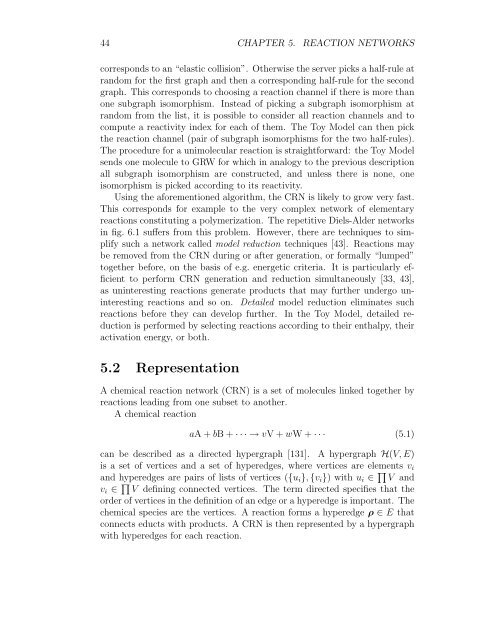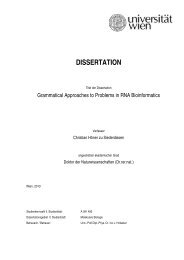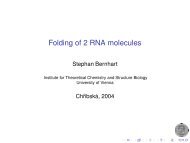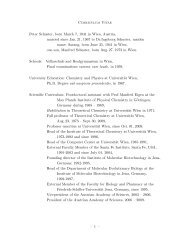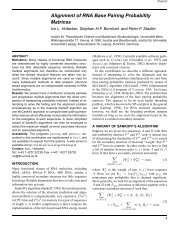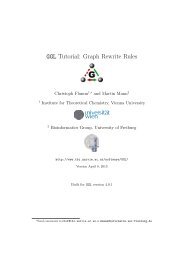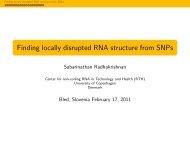A Toy Model of Chemical Reaction Networks - TBI - Universität Wien
A Toy Model of Chemical Reaction Networks - TBI - Universität Wien
A Toy Model of Chemical Reaction Networks - TBI - Universität Wien
You also want an ePaper? Increase the reach of your titles
YUMPU automatically turns print PDFs into web optimized ePapers that Google loves.
44 CHAPTER 5. REACTION NETWORKS<br />
corresponds to an “elastic collision”. Otherwise the server picks a half-rule at<br />
random for the first graph and then a corresponding half-rule for the second<br />
graph. This corresponds to choosing a reaction channel if there is more than<br />
one subgraph isomorphism. Instead <strong>of</strong> picking a subgraph isomorphism at<br />
random from the list, it is possible to consider all reaction channels and to<br />
compute a reactivity index for each <strong>of</strong> them. The <strong>Toy</strong> <strong>Model</strong> can then pick<br />
the reaction channel (pair <strong>of</strong> subgraph isomorphisms for the two half-rules).<br />
The procedure for a unimolecular reaction is straightforward: the <strong>Toy</strong> <strong>Model</strong><br />
sends one molecule to GRW for which in analogy to the previous description<br />
all subgraph isomorphism are constructed, and unless there is none, one<br />
isomorphism is picked according to its reactivity.<br />
Using the aforementioned algorithm, the CRN is likely to grow very fast.<br />
This corresponds for example to the very complex network <strong>of</strong> elementary<br />
reactions constituting a polymerization. The repetitive Diels-Alder networks<br />
in fig. 6.1 suffers from this problem. However, there are techniques to simplify<br />
such a network called model reduction techniques [43]. <strong>Reaction</strong>s may<br />
be removed from the CRN during or after generation, or formally “lumped”<br />
together before, on the basis <strong>of</strong> e.g. energetic criteria. It is particularly efficient<br />
to perform CRN generation and reduction simultaneously [33, 43],<br />
as uninteresting reactions generate products that may further undergo uninteresting<br />
reactions and so on. Detailed model reduction eliminates such<br />
reactions before they can develop further. In the <strong>Toy</strong> <strong>Model</strong>, detailed reduction<br />
is performed by selecting reactions according to their enthalpy, their<br />
activation energy, or both.<br />
5.2 Representation<br />
A chemical reaction network (CRN) is a set <strong>of</strong> molecules linked together by<br />
reactions leading from one subset to another.<br />
A chemical reaction<br />
aA + bB + · · · → vV + wW + · · · (5.1)<br />
can be described as a directed hypergraph [131]. A hypergraph H(V, E)<br />
is a set <strong>of</strong> vertices and a set <strong>of</strong> hyperedges, where vertices are elements v i<br />
and hyperedges are pairs <strong>of</strong> lists <strong>of</strong> vertices ({u i }, {v i }) with u i ∈ ∏ V and<br />
v i ∈ ∏ V defining connected vertices. The term directed specifies that the<br />
order <strong>of</strong> vertices in the definition <strong>of</strong> an edge or a hyperedge is important. The<br />
chemical species are the vertices. A reaction forms a hyperedge ρ ∈ E that<br />
connects educts with products. A CRN is then represented by a hypergraph<br />
with hyperedges for each reaction.


